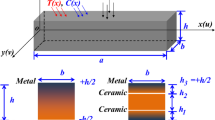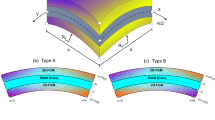Abstract
The purpose of this paper is to present formulations for beam elements based on the absolute nodal co-ordinate formulation that can be effectively and efficiently used in the case of thin structural applications. The numerically stiff behaviour resulting from shear terms in existing absolute nodal co-ordinate formulation beam elements that employ the continuum mechanics approach to formulate the elastic forces and the resulting locking phenomenon make these elements less attractive for slender stiff structures. In this investigation, additional shape functions are introduced for an existing spatial absolute nodal co-ordinate formulation beam element in order to obtain higher accuracy when the continuum mechanics approach is used to formulate the elastic forces. For thin structures where bending stiffness can be important in some applications, a lower order cable element is introduced and the performance of this cable element is evaluated by comparing it with existing formulations using several examples. Cables that experience low tension or catenary systems where bending stiffness has an effect on the wave propagation are examples in which the low order cable element can be used. The cable element, which does not have torsional stiffness, can be effectively used in many problems such as in the formulation of the sliding joints in applications such as the spatial pantograph/catenary systems. The numerical study presented in this paper shows that the use of existing implicit time integration methods enables the simulation of multibody systems with a moderate number of thin and stiff finite elements in reasonable CPU time.
Similar content being viewed by others
References
Shabana, A. A., Dynamics of Multibody Systems, 2nd edn., Cambridge University Press, Cambridge, 1998.
Ryu, J., Kim, S. S., and Kim, S. S., ‘A general approach to stress stiffening effects on flexible multibody dynamic systems,’ Mechanics of Structures and Machines 22, 1994, 157–180.
Rodríguez, J. I., Jiménez, J. M., Funes, F. M., and García de Jalón, J., ‘Recursive and residual algorithms for the efficient numerical integration of multi-body systems,’ Multibody System Dynamics 11, 2004, 295–320.
Yakoub, R. Y. and Shabana, A. A., ‘Use of Cholesky coordinates and the absolute nodal coordinate formulation in the computer simulation of flexible multibody systems,’ Nonlinear Dynamics 20, 1999, 267–282.
Gerstmayr, J., ‘The absolute coordinate formulation with reduced strain for the efficient simulation of flexible multibody systems with nonlinear constraints,’ in Proceedings of the ECCOMAS 2004, P. Neittaanmäki, T. Rossi, S. Korotov, E. Oñate, J. Périaux, and D. Knörzer (eds.), Jyväskylä, Helsinki, 2004.
Shabana, A. A., Hussien, H. A., and Escalona, J. L., ‘Application of the absolute nodal coordinate formulation to large rotation and large deformation problems,’ ASME Journal of Mechanical Design 120, 1998, 188–195.
Buckham, B., Driscoll, F. R., and Nahon, M., ‘Development of a finite element cable model for use in low-tension dynamics simulation,’ Journal of Applied Mechanics 71, 2004, 476–485.
Poetsch, G., Evans, J., Meisinger, R., Kortuem, W., Baldauf, W., Veitl, A., and Wallaschek, J., ‘Pantograph/catenary dynamics and control,’ Vehicle System Dynamics 28, 1997, 159–195.
Sugiyama, H. and Shabana, A. A., ‘Use of plasticity theory in flexible multibody system dynamics,’ in Proceedings of DETC'03 ASME Design Engineering Technical Conferences, Chicago, IL, 2003, Paper No. VIB-48326.
Sopanen, J. T. and Mikkola, A. M., ‘Description of elastic forces in absolute nodal coordinate formulation,’ Nonlinear Dynamics 34, 2003, 53–74.
Dmitrochenko, O. N. and Pogorelov, D. Y., ‘Generalization of plate finite elements for absolute nodal coordinate formulation,’ Multibody System Dynamics 10, 2003, 17–43.
Von Dombrowski, S., ‘Analysis of large flexible body deformation in multibody systems using absolute coordinates,’ Multibody System Dynamics 8, 2002, 409–432.
Yakoub, R. Y. and Shabana, A. A., ‘Three dimensional absolute nodal coordinate formulation for beam elements,’ ASME Journal of Mechanical Design 123, 2001, 606–621.
Simo, J. C. and Vu Quoc, L., ‘On the dynamics of flexible beams under large overall motions, the plane case. Part I,’ Journal of Applied Mechanics 53, 1986, 849–863.
Bathe, K.-J., Finite Element Procedures in Engineering Analysis, Prentice-Hall, Englewood Cliffs, NJ, 1982.
Braess, D., Finite Elements – Theory, Fast Solvers, and Applications in Solid Mechanics, Cambridge University Press, Cambridge, 1997.
Sugiyama, H., Gerstmayr, J., and Shabana, A. A., ‘Deformation modes of the finite element cross section,’ Technical Report MBS05-2-UIC, Department of Mechanical Engineering, University of Illinois at Chicago, 2005.
Simo, J. C. and Rifai, M. S., ‘A class of mixed assumed strain methods and the method of incompatible modes,’ International Journal for Numerical Methods in Engineering 29, 1990, 1595–1638.
Rade, L. and Westergren, B., Mathematics Handbook for Science and Engineering, 4th edn., Springer-Verlag, Berlin Heidelberg, 1999.
Sugiyama, H., Escalona, J. L., and Shabana, A. A., ‘Formulation of three-dimensional joint constraints using the absolute nodal coordinates,’ Nonlinear Dynamics 31, 2003, 167–195.
Wu, S. C. and Haug, E. J., ‘Geometric non-linear substructuring for dynamics of flexible mechanical systems,’ International Journal for Numerical Methods in Engineering 26, 1988, 2211–2226.
Muñoz, J. J. and Jelenić, G., ‘Sliding contact conditions using the master–slave approach with application on geometrically non-linear beams,’ International Journal of Solids and Structure 41, 2004, 6963–6992.
Teichelmann, G., Schaub, M., and Simeon, B., ‘Modelling and simulation of railway cable systems,’ Zeitschrift für Angewandte Mathematik und Mechanik 85(12), 2005, 864–877.
Schwab, A. L. and Meijaard, J. P., Proceedings of IDETC/CIE 2005 ASME 2005 International Design Engineering Technical Conferences & Computers and Information in Engineering Conference 2005, Long Beach, California, USA. Paper No. DETC2005-85104.
Author information
Authors and Affiliations
Corresponding author
Rights and permissions
About this article
Cite this article
Gerstmayr, J., Shabana, A.A. Analysis of Thin Beams and Cables Using the Absolute Nodal Co-ordinate Formulation. Nonlinear Dyn 45, 109–130 (2006). https://doi.org/10.1007/s11071-006-1856-1
Received:
Accepted:
Published:
Issue Date:
DOI: https://doi.org/10.1007/s11071-006-1856-1




